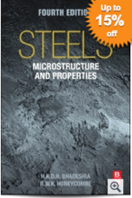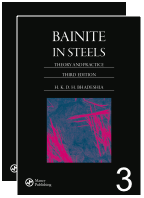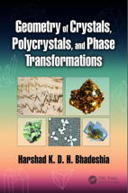
Modelling Precipitation Sequences in Power Plant Steels
J. D. Robson and H. K. D. H. Bhadeshia
Abstract
Part I: Application of Kinetic Theory
The ability of steels to resist creep deformation depends on the presence in the microstructure of carbides and intermetallic compounds which precipitate during tempering or during elevated temperature service. The precipitation occurs in a sequence which leads towards thermodynamic equilibrium. The present paper deals with an extension of the Johnson-Mehl-Avrami theory for overall transformation kinetics. The modification permits the treatment of more than one precipitation reaction occurring simultaneously, a feature which is found to be essential for representing the reactions observed experimentally in a wide range of secondary hardening steels.
Download paper, Materials Science and Technology, 28A (1997) 631-639.
Addendum
Abstract
Part II: Application of Kinetic Theory
New kinetic theory capable of dealing with the simultaneous precipitation of several phases has been applied to a variety of creep resistant power plant steels. It has been demonstrated that the model has the ability to preict the vast differences in precipitation kinetics reported in the published literature for power plant steels. New experimental results on precipitation in a 9Cr1Mo type steel are reported and shown to be consistent with theoretical precitions.
Download paper, Materials Science and Technology, 28A (1997) 640-644.
Software appropriate to this work.
Creep-Resistant Alloys
Ferritic Steels
- "The Microstructure as a Time-Temperature Recorder: Remaining Life Prediction"
Heat and Surface '92,
ed. I. Tamura,
Japan Technical Information Service, Tokyo, 1992, pp. 19-24.
H. K. D. H. Bhadeshia
- "Carbide Composition Changes in Power Plant Steels.
Part I: Bainitic Microstructures"
Materials Science and Technology, Vol. 10, 1994, 193-204.
R. C. Thomson and H. K. D. H. Bhadeshia
- "Carbide Composition Changes in Power Plant Steels.
Part II: Mixed Microstructures"
Materials Science and Technology, Vol. 10, 1994, 205-208.
R. C. Thomson and H. K. D. H. Bhadeshia
- "Atom Probe and STEM studies of Carbide Precipitation in 2.25Cr1Mo Steel"
Applied Surface Science, Vol. 67, 1993, 334-341.
R. C. Thomson and H. K. D. H. Bhadeshia
- "Carbide Compositions in 12Cr1MoV Power Plant Steel"
Metallurgical Transactions A, Vol. 23A, 1992, pp. 1171-1179.
R. C. Thomson and H. K. D. H. Bhadeshia
- "Carbide Precipitation Sequences during the Carburisation of CrMo Steels"
Materials Science and Technology, Vol. 8, 1992, 875-882.
J. M. Race and H. K. D. H. Bhadeshia
- "Modelling the Carbide Composition Changes in CrMoV Steel
During Long Term Ageing"
Materials Science and Engineering A, Vol. A154, 1992, 197-205.
X. Du, R. C. Thomson, J. A. Whiteman and H. K. D. H. Bhadeshia
- "A New Model for Simultaneous Transformation Kinetics in Power Plant
Steels"
Proceedings of Creep '96: Creep Resistant Metallic Materials,
published by Vítkovice, Ostrava, Czech Republic, 1996, pp. 83-91.
J. D. Robson and H. K. D. H. Bhadeshia
- "Kinetics of Precipitation in Power Plant Steels"
Calphad, Vol. 20, 1996, pp. 447-460.
J. D. Robson and H. K. D. H. Bhadeshia
- "Modelling the Mechanical Properties in the HAZ of Power
Plant Steels"Mathematical Modelling of
Weld Phenomena-3,
eds. H. Cerjak and H. K. D. H.
Bhadeshia, Institute of Materials, 1997, 403-442.
T. Cool, H. K. D. H. Bhadeshia and D. J. C. MacKay
- "Modelling the Development of Microstructure in Power Plant Steels"
Microstructural development and stability in high chromium
ferritic power plant steels,
eds. A. Strang and D. J. Gooch,
Institute of Materials, London, 1997, pp. 179-208
J. D. Robson and H. K. D. H. Bhadeshia
- "Modelling Precipitation Sequences in Power Plant Steels:
Part I, Kinetic Theory"
Materials Science and Technology, Vol. 13, 1997, pp. 631-639
J. D. Robson and H. K. D. H. Bhadeshia
- "Modelling Precipitation Sequences in Power Plant Steels:
Part II, Application of Kinetic Theory"
Materials Science and Technology, Vol. 13, 1997, pp. 640-644
J. D. Robson and H. K. D. H. Bhadeshia
- "Modelling the Mechanical Properties in the HAZ of Power Plant Steels"
Mathematical Modelling of Weld Phenomena-3, eds. H. Cerjak and H. K. D. H. Bhadeshia, Institute of Materials, 1997, 403-442.
T. Cool, H. K. D. H. Bhadeshia and D. J. C. MacKay
- "Modelling the Development of Microstructure in Power Plant Steels"
Microstructural development and stability in high chromium ferritic power plant steels, eds. A. Strang and D. J. Gooch, Institute of Materials, London, 1997, pp. 179-208
J. D. Robson and H. K. D. H. Bhadeshia
- "Austenite Formation in 9Cr1Mo Type Power Plant Steels"
Science and Technology of Welding and Joining, Vol. 2, 1997, pp. 36-42.
T. Cool and H. K. D. H. Bhadeshia
- "A New Model for Simultaneous Transformation Kinetics in Power Plant Steels"
Proceedings of Creep '96: Creep Resistant Metallic Materials, published by V\'itkovice, Ostrava, Czech Republic, 1996, pp. 83-91.
J. D. Robson and H. K. D. H. Bhadeshia
- "Theoretical Design of Ferritic Creep-Resistant Steels using Neural Network, Kinetic and Thermodynamic Models"
Materials Science and Technology, Vol. 15 (1999) 547-554.
F. Brun, T. Yoshida, J. D. Robson, V. Narayan and H. K. D. H. Bhadeshia and D. J. C. MacKay
- "Power Plant Steels: Remanent Life Assessment and the Approach to Equilibrium
4th International Charles Parsons Turbine Conference, Advances in Turbine Materials, Design and Manufacturing, eds A. Strang, W. M. Banks, R. D. Conroy and M. J. Goulette, Institute of Materials, London, 1997, 718-741.
H. K. D. H. Bhadeshia
- "Design of Creep-Resistant Steel Welds"
Trends in Welding Research, eds S. A. David, T. DebRoy, J. A. Johnson, H. B. Smartt and J. M. Vitek, ASM International, Ohio, 1999, pp. 795-804.
H. K. D. H. Bhadeshia
- "Precipitation Reactions in 3Cr1Mo Power Plant Steel"
Advanced Heat Resistant Steel for Power Generation, eds R. Viswanathan and J. Nutting, Institute of Materials, London, 1998, pp. 223-233.
N. Fujita and H. K. D. H. Bhadeshia
- "Ferritic Power Plant Steels: Remanent Life Assessment and The Approach to Equilibrium"
International Materials Reviews, Vol. 43, 1998, 45-69.
H. K. D. H. Bhadeshia, A. Strang and D. J. Gooch
- "Microstructural stability of creep resistant alloys for high temperature power plant applications"
edited by A. Strang, J. Cawley and G. W. Greenwood, Institute of Materials, London, (1998) 395-404.
J. D. Robson and H. K. D. H. Bhadeshia
- "Precipitation Reactions in 10CrMoV Steel: Comparison with Theory"
Modelling of Microstructural Evolution in Creep Resistant Materials, eds A. Strang and M. McLean, The Institute of Materials, London, 1999, pp. 105-114.
N. Fujita and H. K. D. H. Bhadeshia
- "Calculation of Precipitation Kinetics in CrMoV Power Plant Steels"
Modelling of Microstructural Evolution in Creep Resistant Materials, eds A. Strang and M. McLean, The Institute of Materials, London, 1999, pp. 115-128.
J. D. Robson and H. K. D. H. Bhadeshia
- "Modelling of Microstructural Development in Creep Resistant 12Cr Power Plant Steels"
Modelling of Microstructural Evolution in Creep Resistant Materials, eds A. Strang and M. McLean, The Institute of Materials, London, 1999, pp. 129-150.
A. Strang, V. Vodarek and H. K. D. H. Bhadeshia
- "Estimation of the Microstructure and Properties of Ferritic Creep-Resistant Steels"
Modelling of Microstructural Evolution in Creep Resistant Materials, eds A. Strang and M. McLean, The Institute of Materials, London, 1999, pp. 15-38.
H. K. D. H. Bhadeshia
- "Design of Creep-Resistant Steels"
Proceedings of Ultra-Steel 2000, National Research Institute for Metals, Tsukuba, Japan, 2000, pp. 89-108.
H. K. D. H. Bhadeshia
- "Mechanical Properties of Martensite in Heat-Resistant Steels"
Proceedings of Ultra-Steel 2000, National Research Institute for Metals, Tsukuba, Japan, 2000, pp. 205-214.
H. K. D. H. Bhadeshia
- "Royal Society Charles Algernon Parsons Memorial Lecture, 2000"
Proceedings of Parsons 2000, Advanced Materials for 21st Century Turbines and Power Plant, eds A. Strang, W. M. Banks, R. D. Conroy, G. M. McColvin, J. C. Neal and S. Simpson, published by The Institute of Materials, London, 2000, pp. 4-39.
Also published in ISIJ International, Vol. 41, 2001, 626-640.
H. K. D. H. Bhadeshia
- Simultaneous alloy carbide sequence in power plant steels
ISIJ International, Vol. 42, 2002, 760-769.
N. Fujita and H. K. D. H. Bhadeshia
- "Design of Creep-Resistant Steels: Success and Failure of Models"
Japan Society for the Promotion of Science, Vol. 44, 2003, 299-314.
H. K. D. H. Bhadeshia and T. Sourmail
- " Microstructural Stability of Strong 9-12 wt% Cr Steels"
Proceedings of Super-High Strength Steels, 2-4 November 2005, Rome, Italy, Associazione Italian di Metallurgica, pp. 1-10.
H. K. D. H. Bhadeshia
- "Estimation of Type IV Cracking Tendency in Power Plant Steels"
ISIJ International, Vol. 44, 2004, pp. 1966-1968.
J. Francis, W. Mazur and H. K. D. H. Bhadeshia
- "Weld Procedures and Type IV Phenomena"
Trends in Welding Research, Atlanta, Georgia, 2005, ASM International, eds S. A. David, T. DebRoy, J. C. Lippold, H. B. Smart and J. M. Vitek, 2005, pp. 737--742.
J. Francis, W. Mazur and H. K. D. H. Bhadeshia
- " Microstructural Stability of Strong 9-12 wt% Cr Steels"
Proceedings of Super-High Strength Steels, 2-4 November 2005, Rome, Italy, Associazione Italian di Metallurgica, pp. 1-10.
H. K. D. H. Bhadeshia
- "Type IV Cracking in Ferritic Power-Plant Steels"
Materials Science and Technology, Vol. 22, 2006, pp. 1387-1395.
J. Francis, W. Mazur and H. K. D. H. Bhadeshia
- "Strong Ferritic-Steel Welds"
Materials Science Forum, Vols 539-543, 2007, pp. 6-11.
H. K. D. H. Bhadeshia
- Frontiers in the Modelling of Steel Weld Deposits"
Journal of the Japan Welding Society, Vol. 76, 2007, pp. 26-32.
H. K. D. H. Bhadeshia
- "Hot-Strength of Creep-Resistant Ferritic Steels and Relationship to Creep-Rupture Data"
Materials Science and Technology, Vol. 23, 2007, 1127--1131
R. C. Dimitriu and H. K. D. H. Bhadeshia
- "Creep strength of high-Cr ferritic steels designed using neural networks and phase stability calculations"
Fifth Int. Conf. on Advances in Materials Technology for Fossil Power Plants October 3-5 (2007) 4B-01. Published by EPRI, Palo Alto, California, USA
F. Masuyama and H. K. D. H. Bhadeshia
- "Hot-Strength of Ferritic Creep-Resistant Steels Comparison of Neural Network and Genetic Programming"
Materials and Manufacturing Processes 24 (2009) 10-15.
R. C. Dimitriu, H. K. D. H. Bhadeshia, C. Fillon and C. Poloni
Austenitic Steels
- "Neural network model of creep strength of austenitic stainless steels"
Materials Science and Technology, Vol. 18, 2002, 655-663.
T. Sourmail, H. K. D. H. Bhadeshia and D. J. C. MacKay
- "Review: Precipitation in Creep-Resistant Austenitic Stainless Steels"
Materials Science and Technology, Vol. 17, 2001. pp. 1-14.
T. Sourmail
- "Microstructural evolution in two variants of NF709 at 1023 and 1073 K"
Metallurgical and Materials Transactions A Vol. 36A, 2005, pp. 23-34.
T. Sourmail and H. K. D. H. Bhadeshia
- "Welding Procedures and Type IV Cracking: An Experimental Study"
3rd International Conference on Integrity of High Temperature Welds, 24-26 April 2007, pp.399-408, IOM Communications Ltd., London, ISBN 1-86125-166-1.
J. Francis, W. Mazur and H. K. D. H. Bhadeshia
- "Microstructural evolution in two variants of NF709 at 1023 and 1073 K"
Metallurgical and Materials Transactions A Vol. 36A, 2005, pp. 23-34.
T. Sourmail and H. K. D. H. Bhadeshia






